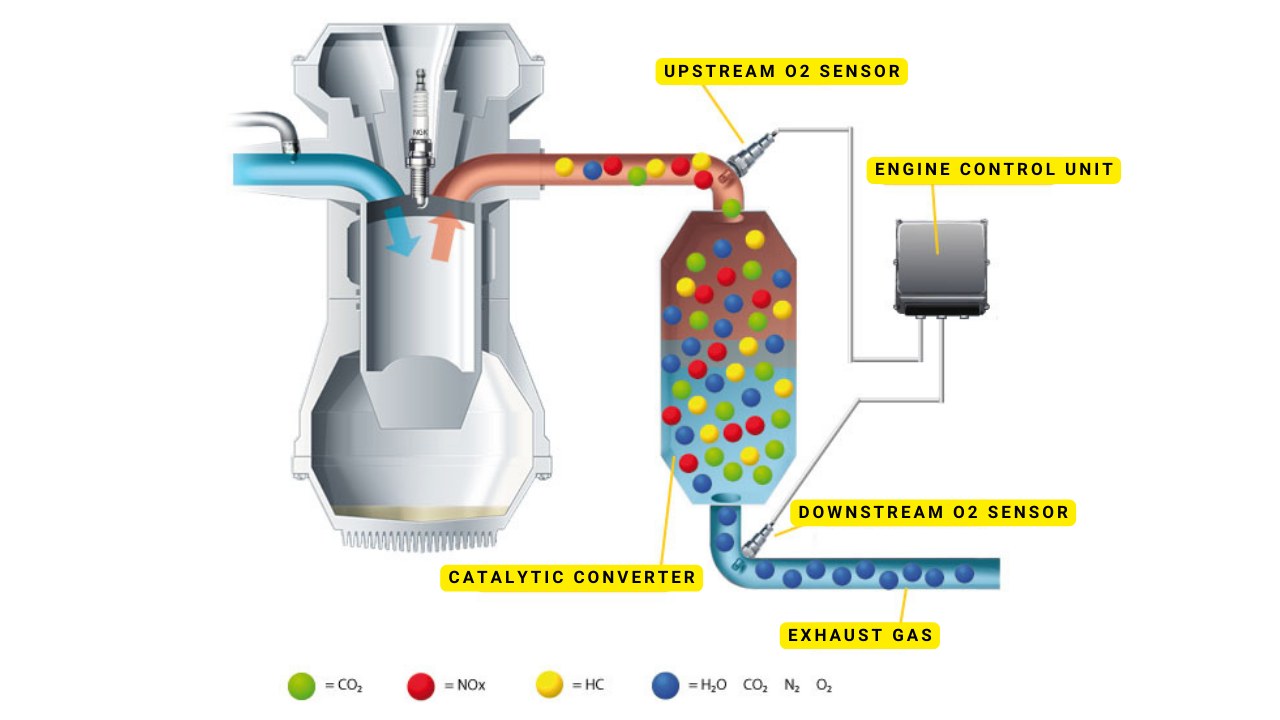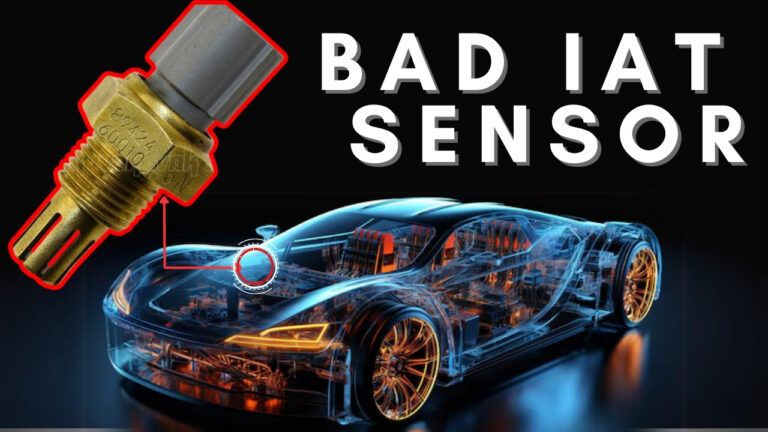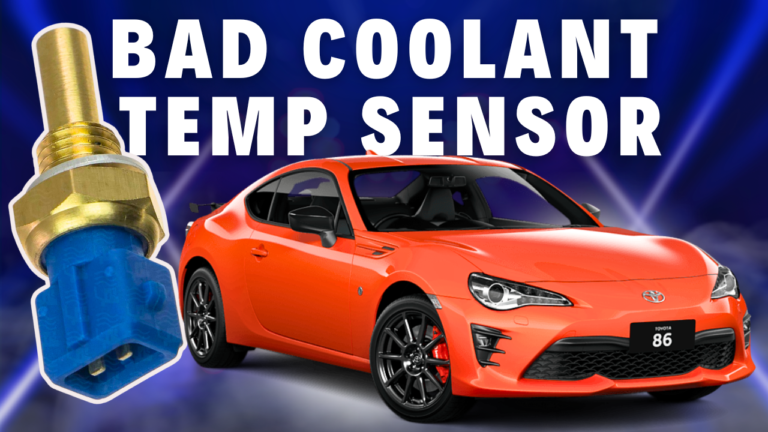What is an Oxygen Sensor?
An oxygen sensor, also known as an O2 sensor, is an essential component in controlling the exhaust emissions of petrol, diesel, and gas engines. It measures the residual oxygen content in the exhaust gases and sends this information to the engine control unit (ECU).
The sensor’s readings help the ECU determine whether the air-fuel mixture is too lean (not enough fuel) or too rich (too much fuel). Based on this information, the ECU adjusts the fuel injection system to maintain an optimal air-fuel ratio for efficient combustion and reduced emissions.
Where is Oxygen Sensor Located?
The oxygen sensor is typically located in the exhaust system of a vehicle. Its precise placement may vary depending on the vehicle’s make and model, as well as the number of sensors installed. The number of sensors installed depends on the number of catalytic converters it has. Generally, each catalytic converter has two oxygen sensors: an upstream and a downstream sensor.
The upstream sensor is situated before the catalytic converter. It helps the engine control unit (ECU) adjust the air-fuel mixture for efficient combustion based on the residual oxygen content in the exhaust system.
The downstream sensor is located after the catalytic converter. It measures the oxygen content of the exhaust gas that has passed through the catalytic converter and monitors the converter’s efficiency.

Bad Oxygen Sensor Symptoms
A malfunctioning Oxygen Sensor can manifest in various symptoms, indicating potential issues with the vehicle’s performance:
- Check Engine Light Comes On: While a check engine light can indicate various problems, a malfunctioning oxygen sensor is a frequent trigger. This happens because the engine control unit (ECU) detects issues related to the oxygen sensor and triggers relevant fault codes. A detailed list of fault codes associated with oxygen sensor issues is covered in this blog.
- Noticeable Loss of Fuel Efficiency: If the oxygen sensor fails to accurately measure the exhaust oxygen content, the ECU may inaccurately adjust the air-fuel ratio, causing the engine to run too rich or too lean. Running rich means there is excess fuel in the mixture, leading to decreased fuel economy. On the other hand, running lean indicates insufficient fuel, which can also result in poor gas mileage. If you notice a sudden decrease in fuel efficiency or consistently lower mileage than usual, it could be a sign of a failing oxygen sensor.
- Strong Odors from Exhaust: A bad oxygen sensor can cause the engine to run rich, meaning there is an excess of unburned fuel in the exhaust. This can lead to strong and unpleasant odors, such as a sulfuric smell or the distinct scent of gasoline. If you notice these smells coming from your exhaust, it’s an indication that the oxygen sensor is not accurately measuring the air-fuel mixture, resulting in an improper combustion process.
- Black Smoke from Exhaust: Another visual symptom of a faulty oxygen sensor is the presence of black smoke coming from the exhaust. When the air-fuel mixture is imbalanced due to a malfunctioning sensor, it can lead to incomplete combustion. The unburned fuel exits the engine as black smoke, indicating a problem with the combustion process. Not only does this contribute to poor fuel efficiency, but it also increases harmful emissions and can potentially damage the catalytic converter.
- Failed Emissions Test: If your vehicle fails an emissions test, a faulty oxygen sensor is a likely culprit. Oxygen sensors are crucial components of the emissions control system. They help monitor the efficiency of the catalytic converter and ensure the reduction of harmful exhaust gases. A malfunctioning sensor can result in elevated emissions, causing your vehicle to fail the emissions test. If your vehicle does not meet the required emission standards, it’s essential to have the oxygen sensor checked and replaced if necessary.
- Unusual Engine Sounds: A failing oxygen sensor can contribute to unusual engine sounds, such as pinging, knocking, or rattling noises. When the air-fuel mixture is imbalanced, it can lead to carbon buildup in the combustion chamber, resulting in these abnormal sounds.
Common Oxygen Sensor fault codes
Here is a list of codes that are associated with the bad Oxygen Sensor:
- P0130: O2 Sensor Circuit Malfunction (Bank 1, Sensor 1)
- P0131: O2 Sensor Circuit Low Voltage (Bank 1, Sensor 1)
- P0132: O2 Sensor Circuit High Voltage (Bank 1, Sensor 1)
- P0133: O2 Sensor Circuit Slow Response (Bank 1, Sensor 1)
- P0134: O2 Sensor Circuit No Activity Detected (Bank 1, Sensor 1)
- P0135: O2 Sensor Heater Circuit Malfunction (Bank 1, Sensor 1)
- P0136: O2 Sensor Circuit Malfunction (Bank 1, Sensor 2)
- P0137: O2 Sensor Circuit Low Voltage (Bank 1, Sensor 2)
- P0138: O2 Sensor Circuit High Voltage (Bank 1, Sensor 2)
- P0139: O2 Sensor Circuit Slow Response (Bank 1, Sensor 2)
- P0140: O2 Sensor Circuit No Activity Detected (Bank 1, Sensor 2)
- P0141: O2 Sensor Heater Circuit Malfunction (Bank 1, Sensor 2)
- P0142: O2 Sensor Circuit Malfunction (Bank 1, Sensor 3)
- P0143: O2 Sensor Circuit Low Voltage (Bank 1, Sensor 3)
- P0144: O2 Sensor Circuit High Voltage (Bank 1, Sensor 3)
- P0145: O2 Sensor Circuit Slow Response (Bank 1, Sensor 3)
- P0146: O2 Sensor Circuit No Activity Detected (Bank 1, Sensor 3)
- P0147: O2 Sensor Heater Circuit Malfunction (Bank 1, Sensor 3)
- P0150: O2 Sensor Circuit Malfunction (Bank 2, Sensor 1)
- P0151: O2 Sensor Circuit Low Voltage (Bank 2, Sensor 1)
- P0152: O2 Sensor Circuit High Voltage (Bank 2, Sensor 1)
- P0153: O2 Sensor Circuit Slow Response (Bank 2, Sensor 1)
- P0154: O2 Sensor Circuit No Activity Detected (Bank 2, Sensor 1)
- P0155: O2 Sensor Heater Circuit Malfunction (Bank 2, Sensor 1)
- P0156: O2 Sensor Circuit Malfunction (Bank 2, Sensor 2)
- P0157: O2 Sensor Circuit Low Voltage (Bank 2, Sensor 2)
- P0158: O2 Sensor Circuit High Voltage (Bank 2, Sensor 2)
- P0159: O2 Sensor Circuit Slow Response (Bank 2, Sensor 2)
- P0160: O2 Sensor Circuit No Activity Detected (Bank 2, Sensor 2)
- P0161: O2 Sensor Heater Circuit Malfunction (Bank 2, Sensor 2)
- P0162: O2 Sensor Circuit Malfunction (Bank 2, Sensor 3)
- P0163: O2 Sensor Circuit Low Voltage (Bank 2, Sensor 3)
- P0164: O2 Sensor Circuit High Voltage (Bank 2, Sensor 3)
- P0165: O2 Sensor Circuit Slow Response (Bank 2, Sensor 3)
- P0166: O2 Sensor Circuit No Activity Detected (Bank 2, Sensor 3)
- P0167: O2 Sensor Heater Circuit Malfunction (Bank 2, Sensor 3)
What Causes the Malfunction of Oxygen Sensor ?
Causes of a Faulty Oxygen Sensor
- Mechanical Damage: Physical damage to the sensor or its components can impair its ability to function correctly. This can result from impacts, vibrations, or improper handling during maintenance.
- Carbon Buildup: Over time, carbon deposits can accumulate on the sensor, hindering its ability to accurately measure the oxygen content in the exhaust gases.
- Internal Short Circuits: Electrical issues within the sensor itself, such as short circuits, can prevent it from sending correct signals to the Engine Control Module.
- Electrical issue: Poor connections across electrical connectors, broken wiring, blown fuses, loss of ground, or issues with previously repaired wires can disrupt the connection with the Oxygen Sensor.
Other Issues That Exhibit Similar Symptoms as a Bad Oxygen Sensor
When a car exhibits the symptoms mentioned above, and the Oxygen Sensor has been checked and found to be in working order but the issue persists, it’s essential to inspect the other components that influence the air-fuel ratio. These components can also cause imbalances in the air-fuel mixture and similar symptoms.
- Faulty Mass Air Flow (MAF) Sensor: The MAF sensor measures the mass of air entering the engine, providing crucial data for calculating the air-fuel ratio. If the sensor malfunctions, it can cause incorrect readings, leading to imbalances in the air-fuel mixture.
- Faulty Manifold Absolute Pressure (MAP) Sensor: The MAP sensor measures the pressure of air entering the engine manifold. This data is essential for calculating the air-fuel ratio. If the sensor malfunctions, it can cause incorrect readings, resulting in imbalances in the air-fuel mixture.
- Faulty Throttle Position Sensor (TPS): The TPS monitors the position of the throttle valve and provides crucial data for calculating the appropriate air-fuel ratio for combustion. If the TPS malfunctions and provides inaccurate readings, it can disrupt the air-fuel mixture, leading to symptoms similar to those caused by a faulty oxygen sensor.
- Faulty Fuel Injectors: Dirty or clogged fuel injectors can disrupt the fuel spray pattern, causing an improper air-fuel mixture. This can lead to symptoms such as poor fuel economy, engine misfires, and rough idling, which are similar to those caused by a bad oxygen sensor.




